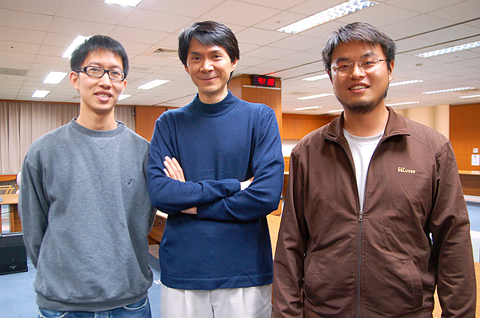A breakthrough has shed light on the biological mystery of why there are so many different types of species in the world after the discovery of a “speciation” gene in budding yeast by Academia Sinica (AS) researcher Leu Jun-yi (呂俊毅), the academy announced yesterday.
Leu’s finding was published in the renowned journal Cell on Friday, it added.
Speciation is the process in which one type of organism evolves — most of the time because of environmental factors — into two or more different species, Leu said, adding that a speciation gene is one that is involved in such a process.

PHOTO: HSIEH WEN-HUA, TAIPEI TIMES
“The question we want to ask is, why are there so many different species in the world?” he said. “Like cars of different brands, although they look alike, they function differently. For example a Porsche runs faster than a Ford, but a Ford is more energy efficient ... [Similarly] we want to know why [this occurs in different species].”
One function of speciation genes is that after organisms evolve into different species to adapt to different environments, the speciation genes make sure that the resulting different species cannot be crossbred, Leu said. In other words, the genes maintain novel adaptations during evolution, because they lose proper functions when mixed with alleles from other species.
“An example is the horse and the donkey — although they look very similar, they produce mules, which are sterile ... There are other examples where the offspring die as fertilized eggs,” he said.
Without such function, the species may lose its characteristics vital for survival, Leu said.
“For example, if a fish was crossed with a dog, the resulting offspring may be a creature that cannot function well in water or on land,” he said.
Although the speciation gene concept was discovered more than 80 years ago by famous US geneticist Theodore Dobzhansky and Hermann Muller, few speciation genes have been identified in organisms to date, Leu said.
Recently, Leu’s team discovered a gene in two similar yeasts that makes their offspring sterile, which sheds light on how the mechanism of speciation takes place.
“When crossbred, the mitochondria [the “cellular power plant” that provides energy to cells] and the nucleus [control center] of cells in the yeast do not function properly,” Leu said.
Because one yeast relies on non-fermentable carbon sources for energy, while the other depends on fermentation, the discovery also provides support for Leu’s postulation that the mitochondria in different species evolved to be different because of the ways they consume energy, he said.
Asked how his discovery could impact the field of evolutionary biology, Leu said the influence is two-fold.
“Although speciation genes have been discovered before, we can provide a clear description how this particular speciation gene functions; this is because we have a strong database documenting the functions of genes in yeasts,” he said.
Leu added that as the approach his team took was very systematic, it provides a first step to potentially discovering a universal mechanism for speciation genes.
“We want to figure out whether other yeasts also use the [mitochondria mechanism] … We have a preliminary conclusion that some of them do; [if we confirm that], this mechanism can become a universal mechanism, instead of that for a single case,” he said.

US climber Alex Honnold is to attempt to scale Taipei 101 without a rope and harness in a live Netflix special on Jan. 24, the streaming platform announced on Wednesday. Accounting for the time difference, the two-hour broadcast of Honnold’s climb, called Skyscraper Live, is to air on Jan. 23 in the US, Netflix said in a statement. Honnold, 40, was the first person ever to free solo climb the 900m El Capitan rock formation in Yosemite National Park — a feat that was recorded and later made into the 2018 documentary film Free Solo. Netflix previewed Skyscraper Live in October, after videos

Starting on Jan. 1, YouBike riders must have insurance to use the service, and a six-month trial of NT$5 coupons under certain conditions would be implemented to balance bike shortages, a joint statement from transportation departments across Taipei, New Taipei City and Taoyuan announced yesterday. The rental bike system operator said that coupons would be offered to riders to rent bikes from full stations, for riders who take out an electric-assisted bike from a full station, and for riders who return a bike to an empty station. All riders with YouBike accounts are automatically eligible for the program, and each membership account

A classified Pentagon-produced, multiyear assessment — the Overmatch brief — highlighted unreported Chinese capabilities to destroy US military assets and identified US supply chain choke points, painting a disturbing picture of waning US military might, a New York Times editorial published on Monday said. US Secretary of Defense Pete Hegseth’s comments in November last year that “we lose every time” in Pentagon-conducted war games pitting the US against China further highlighted the uncertainty about the US’ capability to intervene in the event of a Chinese invasion of Taiwan. “It shows the Pentagon’s overreliance on expensive, vulnerable weapons as adversaries field cheap, technologically

NUMBERs IMBALANCE: More than 4 million Taiwanese have visited China this year, while only about half a million Chinese have visited here Beijing has yet to respond to Taiwan’s requests for negotiation over matters related to the recovery of cross-strait tourism, the Tourism Administration said yesterday. Taiwan’s tourism authority issued the statement after Chinese-language daily the China Times reported yesterday that the government’s policy of banning group tours to China does not stop Taiwanese from visiting the country. As of October, more than 4.2 million had traveled to China this year, exceeding last year. Beijing estimated the number of Taiwanese tourists in China could reach 4.5 million this year. By contrast, only 500,000 Chinese tourists are expected in Taiwan, the report said. The report